Zircon (U-Th)/He Closure Temperature Lower Than Apatite Thermochronometric Systems: Reconciliation of a Paradox
Abstract
:1. Introduction
2. Geological Settings
3. Materials and Methods
4. Results
5. Discussion
5.1. Revisiting the ZHe Temperature Sensitivity
5.2. Geological Implication
6. Conclusions
Supplementary Materials
Author Contributions
Funding
Data Availability Statement
Acknowledgments
Conflicts of Interest
References
- Ault, A.K.; Gautheron, C.; King, G.E. Innovations in (U–Th)/He, Fission Track, and Trapped Charge Thermochronometry with Applications to Earthquakes, Weathering, Surface-Mantle Connections, and the Growth and Decay of Mountains. Tectonics 2019, 38, 3705–3739. [Google Scholar] [CrossRef] [Green Version]
- Reiners, P.W.; Brandon, M.T. Using Thermochronology to Understand Orogenic Erosion. Annu. Rev. Earth Planet. Sci. 2006, 34, 419–466. [Google Scholar] [CrossRef] [Green Version]
- Reiners, P.W.; Farley, K.A.; Hickes, H.J. He Diffusion and (U–Th)/He Thermochronometry of Zircon: Initial Results from Fish Canyon Tuff and Gold Butte. Tectonophysics 2002, 349, 297–308. [Google Scholar] [CrossRef]
- Reiners, P.W.; Spell, T.L.; Nicolescu, S.; Zanetti, K.A. Zircon (U-Th)/He Thermochronometry: He Diffusion and Comparisons with 40Ar/39Ar Dating. Geochim. Cosmochim. Acta 2004, 68, 1857–1887. [Google Scholar] [CrossRef]
- Reiners, P.W. Zircon (U-Th)/He Thermochronometry. Rev. Mineral. Geochem. 2005, 58, 151–179. [Google Scholar] [CrossRef]
- Bernet, M. A Field-Based Estimate of the Zircon Fission-Track Closure Temperature. Chem. Geol. 2009, 259, 181–189. [Google Scholar] [CrossRef]
- Brandon, M.T.; Roden-Tice, M.K.; Garver, J.I. Late Cenozoic Exhumation of the Cascadia Accretionary Wedge in the Olympic Mountains, Northwest Washington State. Geol Soc Am Bull 1998, 110, 985–1009. [Google Scholar] [CrossRef]
- Ketcham, R.A. Fission-Track Annealing: From Geologic Observations to Thermal History Modeling. In Fission-Track Thermochronology and Its Application to Geology; Malusà, M., Fitzgerald, P., Eds.; Springer Textbooks in Earth Sciences, Geography and Environment; Springer: Berlin/Heidelberg, Germany, 2019. [Google Scholar]
- Guenthner, W.R.; Reiners, P.W.; Tian, Y. Interpreting Date—EU Correlations in Zircon (U-Th)/He Datasets: A Case Study from the Longmen Shan, China. Earth Planet. Sci. Lett. 2014, 403, 328–339. [Google Scholar] [CrossRef]
- Johnson, J.E.; Flowers, R.M.; Baird, G.B.; Mahan, K.H. “Inverted” Zircon and Apatite (U-Th)/He Dates from the Front Range, Colorado: High-Damage Zircon as a Low-Temperature (<50 °C) Thermochronometer. Earth Planet. Sci. Lett. 2017, 466, 80–90. [Google Scholar] [CrossRef]
- Shuster, D.L.; Flowers, R.M.; Farley, K.A. The Influence of Natural Radiation Damage on Helium Diffusion Kinetics in Apatite. Earth Planet. Sci. Lett. 2006, 249, 148–161. [Google Scholar] [CrossRef]
- Flowers, R.M.; Shuster, D.L.; Wernicke, B.P.; Farley, K.A. Radiation Damage Control on Apatite (U-Th)/He Dates from the Grand Canyon Region, Colorado Plateau. Geology 2007, 35, 447–450. [Google Scholar] [CrossRef]
- Flowers, R.M.; Ketcham, R.A.; Shuster, D.L.; Farley, K.A. Apatite (U-Th)/He Thermochronometry Using a Radiation Damage Accumulation and Annealing Model. Geochim. Cosmochim. Acta 2009, 73, 2347–2365. [Google Scholar] [CrossRef]
- Gautheron, C.; Tassan-Got, L.; Barbarand, J.; Pagel, M. Effect of Alpha-Damage Annealing on Apatite (U–Th)/He Thermochronology. Chem. Geol. 2009, 266, 157–170. [Google Scholar] [CrossRef]
- Guenthner, W.R.; Reiners, P.W.; Ketcham, R.A.; Nasdala, L.; Giester, G. Helium Diffusion in Natural Zircon: Radiation Damage, Anisotropy, and the Interpretation of Zircon (U-Th)/He Thermochronology. Am. J. Sci. 2013, 313, 145. [Google Scholar] [CrossRef]
- Guenthner, W.R. Implementation of an Alpha Damage Annealing Model for Zircon (U-Th)/He Thermochronology with Comparison to a Zircon Fission Track Annealing Model. Geochem. Geophys. Geosyst. 2021, 22, e2019GC008757. [Google Scholar] [CrossRef]
- Ternois, S.; Odlum, M.; Ford, M.; Pik, R.; Stockli, D.; Tibari, B.; Vacherat, A.; Bernard, V. Thermochronological Evidence of Early Orogenesis, Eastern Pyrenees, France. Tectonics 2019, 38, 1308–1336. [Google Scholar] [CrossRef]
- Gautheron, C.; Djimbi, D.M.; Roques, J.; Balout, H.; Ketcham, R.A.; Simoni, E.; Pik, R.; Seydoux-Guillaume, A.-M.; Tassan-Got, L. A Multi-Method, Multi-Scale Theoretical Study of He and Ne Diffusion in Zircon. Geochim. Cosmochim. Acta 2020, 268, 348–367. [Google Scholar] [CrossRef]
- Farley, K.A.; Kohn, B.P.; Pillans, B. The Effects of Secular Disequilibrium on (U–Th)/He Systematics and Dating of Quaternary Volcanic Zircon and Apatite. Earth Planet. Sci. Lett. 2002, 201, 117–125. [Google Scholar] [CrossRef]
- Gérard, B.; Audin, L.; Robert, X.; Gautheron, C.; van der Beek, P.; Bernet, M.; Benavente, C.; Delgado, F. Pliocene River Capture and Incision of the Northern Altiplano: Machu Picchu, Peru. J. Geol. Soc. 2021, 178, jgs2020–jgs2100. [Google Scholar] [CrossRef]
- Marocco, R. Etude géologique de la chaîne andine au niveau de la déflexion d’Abancay (Pérou). Cah. ORSTOM.Série Géologie 1971, 3, 45–57. [Google Scholar]
- Roperch, P.; Carlotto, V.; Ruffet, G.; Fornari, M. Tectonic Rotations and Transcurrent Deformation South of the Abancay Deflection in the Andes of Southern Peru. Tectonics 2011, 30. [Google Scholar] [CrossRef] [Green Version]
- Mišković, A.; Spikings, R.A.; Chew, D.M.; Košler, J.; Ulianov, A.; Schaltegger, U. Tectonomagmatic Evolution of Western Amazonia: Geochemical Characterization and Zircon U-Pb Geochronologic Constraints from the Peruvian Eastern Cordilleran Granitoids. GSA Bull. 2009, 121, 1298–1324. [Google Scholar] [CrossRef]
- Carlier, G.; Grandin, G.; Laubacher, G.; Marocco, R.; Mégard, F. Present Knowledge of the Magmatic Evolution of the Eastern Cordillera of Peru. Earth-Sci. Rev. 1982, 18, 253–283. [Google Scholar] [CrossRef]
- Perez, N.D.; Horton, B.K.; Carlotto, V. Structural Inheritance and Selective Reactivation in the Central Andes: Cenozoic Deformation Guided by Pre-Andean Structures in Southern Peru. Tectonophysics 2016, 671, 264–280. [Google Scholar] [CrossRef] [Green Version]
- Kennan, L. Fission Track Ages and Sedimentary Provenance Studies in Peru, and Their Implications for Andean Paleogeographic Evolution, Stratigraphy and Hydrocarbon Systems. VI INGEPET 2008, 13, 17. [Google Scholar]
- Gérard, B.; Robert, X.; Audin, L.; Valla, P.G.; Bernet, M.; Gautheron, C. Differential Exhumation of the Eastern Cordillera in the Central Andes: Evidence for South-Verging Backthrusting (Abancay Deflection, Peru). Tectonics 2021, 40, e2020TC006314. [Google Scholar] [CrossRef]
- Carlier, G.; Lorand, J.P.; Liégeois, J.P. Potassic-Ultrapotassic Mafic Rocks Delineate Two Lithospheric Mantle Blocks beneath the Southern Peruvian Altiplano. Geology 2005, 33, 601–604. [Google Scholar] [CrossRef]
- Mamani, M.; Wörner, G.; Sempere, T. Geochemical Variations in Igneous Rocks of the Central Andean Orocline (13° S to 18° S): Tracing Crustal Thickening and Magma Generation through Time and Space. Geol. Soc. Am. Bull. 2010, 122, 162–182. [Google Scholar] [CrossRef]
- Carlier, G.; Lorand, J.-P.; Bonhomme, M.; Carlotto, V. A Reappraisal of the Cenozoic Inner Arc Magmatism in Southern Peru: Consequences for the Evolution of the Central Andes for the Past 50 Ma; ISAG: St. Malo, France, 1996; pp. 551–554. [Google Scholar]
- Ruiz, G.M.H.; Carlotto, V.; van Heiningen, P.V.; Andriessen, P.A.M. Steady-State Exhumation Pattern in the Central Andes—SE Peru. In Thermochronological Methods: From Paleotemperature Constraints to Landscape evolution Models; Lisker, F., Ventura, B., Glasmacher, U.A., Eds.; Geological Society, Special Publications: London, UK, 2009; Volume 307, pp. 307–316. [Google Scholar]
- Landry, K.R.; Coutand, I.; Whipp, D.M.; Grujic, D.; Hourigan, J.K. Late Neogene Tectonically Driven Crustal Exhumation of the Sikkim Himalaya: Insights from Inversion of Multithermochronologic Data. Tectonics 2016, 35, 833–859. [Google Scholar] [CrossRef] [Green Version]
- Schmitz, M.D.; Bowring, S.A. U-Pb Zircon and Titanite Systematics of the Fish Canyon Tuff: An Assessment of High-Precision U-Pb Geochronology and Its Application to Young Volcanic Rocks. Geochim. Cosmochim. Acta 2001, 65, 2571–2587. [Google Scholar] [CrossRef]
- Farley, K.A.; Wolf, R.; Silver, L. The Effect of Long Alpha-Stopping Distances on (U-Th)/He Dates. Geochim. Cosmochim. Acta 1996, 60, 4223–4229. [Google Scholar] [CrossRef]
- Farley, K.A. (U-Th)/He Dating: Techniques, Calibrations, and Applications. Rev. Mineral. Geochem. 2002, 47, 819–844. [Google Scholar] [CrossRef]
- Nasdala, L.; Hanchar, J.M.; Kronz, A.; Whitehouse, M.J. Long-Term Stability of Alpha Particle Damage in Natural Zircon. Chem. Geol. 2005, 220, 83–103. [Google Scholar] [CrossRef]
- Bernet, M.; Garver, J.I. Fission-Track Analysis of Detrital Zircon. Rev. Mineral. Geochem. 2005, 58, 205–237. [Google Scholar] [CrossRef]
- Hasebe, N.; Tagami, T.; Nishimura, S. Towards Zircon Fission-Track Thermochronology: Reference Framework for Confined Track Length Measurements. Chem. Geol. 1994, 112, 169–178. [Google Scholar] [CrossRef]
- Garver, J.I. Etching Zircon Age Standards for Fission-Track Analysis. Radiat. Meas. 2003, 37, 47–53. [Google Scholar] [CrossRef]
- Vermeesch, P. RadialPlotter: A Java Application for Fission Track, Luminescence and Other Radial Plots. Radiat. Meas. 2009, 44, 409–410. [Google Scholar] [CrossRef]
- Galbraith, R.F.; Laslett, G.M. Statistical Models for Mixed Fission Track Ages. Nucl. Tracks Radiat. Meas. 1993, 21, 459–470. [Google Scholar] [CrossRef]
- Ehlers, T.A.; Chaudhri, T.; Kumar, S.; Fuller, C.W.; Willett, S.D.; Ketcham, R.A.; Brandon, M.T.; Belton, D.X.; Kohn, B.P.; Gleadow, A.J.W.; et al. Computational Tools for Low-Temperature Thermochronometer Interpretation. Rev. Mineral. Geochem. 2005, 58, 589–622. [Google Scholar] [CrossRef]
- Whipp, D.; Kellett, D.; Coutand, I. Short Communication: Modelling Competing Effects of Cooling Rate, Grain Size and Radiation Damage in Low Temperature Thermochronometers. Geochronol. Discuss. 2021; 1–13, in review. [Google Scholar] [CrossRef]
- Ketcham, R.A. Forward and Inverse Modelling of Low-Temperature Thermochronology Data. Rev. Mineral. Geoch. 2005, 84, 1235–1255. [Google Scholar]
- Bernet, M.; Brandon, M.T.; Garver, J.I.; Molitor, B.R. Fundamentals of Detrital Zircon Fission-Track Analysis for Provenance and Exhumation Studies with Examples from the European Alps. In Detrital thermochronology—Provenance Analysis, Exhumation, and Landscape Evolution of Mountain Belts; Bernet, M., Spiegel, C., Eds.; Geological Society of America: Boulder, CO, USA, 2004; Volume 378, pp. 25–36. ISBN 978-0-8137-2378-5. [Google Scholar]
- Garver, J.I.; Kamp, P.J.J. Integration of Zircon Color and Zircon Fission-Track Zonation Patterns in Orogenic Belts: Application to the Southern Alps, New Zealand. Tectonophysics 2002, 349, 203–219. [Google Scholar] [CrossRef] [Green Version]
- Gordon Gastil, R.; DeLisle, M.; Morgan, J. Some Effects of Progressive Metamorphism on Zircons. GSA Bull. 1967, 78, 879–906. [Google Scholar] [CrossRef]
- Herman, F.; Seward, D.; Valla, P.G.; Carter, A.; Kohn, B.; Willett, S.D.; Ehlers, T.A. Worldwide Acceleration of Mountain Erosion under a Cooling Climate. Nature 2013, 504, 423–426. [Google Scholar] [CrossRef] [PubMed]
- Yamada, K.; Tagami, T. Postcollisional Exhumation History of the Tanzawa TonaliteComplex, Inferred from (U-Th)/He Thermochronologyand Fission Track Analysis. J. Geophys. Res. 2008, 113, 1–10. [Google Scholar] [CrossRef] [Green Version]
- Spencer, C.J.; Danišík, M.; Ito, H.; Hoiland, C.; Tapster, S.; Jeon, H.; McDonald, B.; Evans, N.J. Rapid Exhumation of Earth’s Youngest Exposed Granites Driven by Subduction of an Oceanic Arc. Geophys. Res. Lett. 2019, 46, 1259–1267. [Google Scholar] [CrossRef]
- Ketcham, R.A.; Carter, A.; Donelick, R.A.; Barbarand, J.; Hurford, A. Improved Measurement of Fission-Track Annealing in Apatite Using c-Axis Projection. Am. Mineral. 2007, 92, 789–798. [Google Scholar] [CrossRef]
- Bosch, G.; Teixell, A.; Jolivet, M.; Labaume, P.; Stockli, D.; Domènech, M.; Monié, P. Timing of Eocene—Miocene Thrust Activity in the Western Axial Zone and Chaînons Béarnais (West-Central Pyrenees) Revealed by Multi-Method Thermochronology. Rift. Mt. Build. Pyrenean Belt 2016, 348, 246–256. [Google Scholar] [CrossRef]
- Vacherat, A.; Mouthereau, F.; Pik, R.; Bellahsen, N.; Gautheron, C.; Bernet, M.; Daudet, M.; Balansa, J.; Tibari, B.; Pinna Jamme, R.; et al. Rift-to-Collision Transition Recorded by Tectono-Thermal Evolution of the Northern Pyrenees. Tectonics 2016, 35, 907–933. [Google Scholar] [CrossRef] [Green Version]
- Ginster, U.; Reiners, P.W.; Nasdala, L.; Chanmuang, N.C. Annealing Kinetics of Radiation Damage in Zircon. Geochim. Cosmochim. Acta 2019, 249, 225–246. [Google Scholar] [CrossRef]
- Barnes, J.B.; Ehlers, T.A.; McQuarrie, N.; O’Sullivan, P.B.; Tawackoli, S. Thermochronometer Record of Central Andean Plateau Growth, Bolivia (19.5 °S). Tectonics 2008, 27. [Google Scholar] [CrossRef] [Green Version]
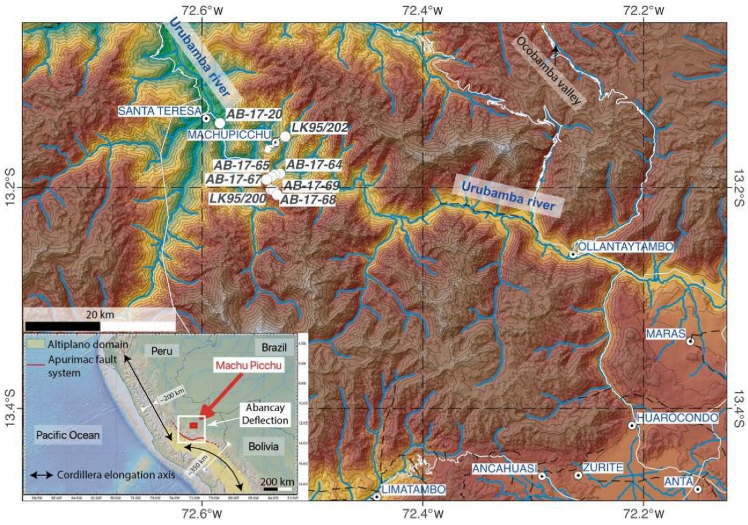
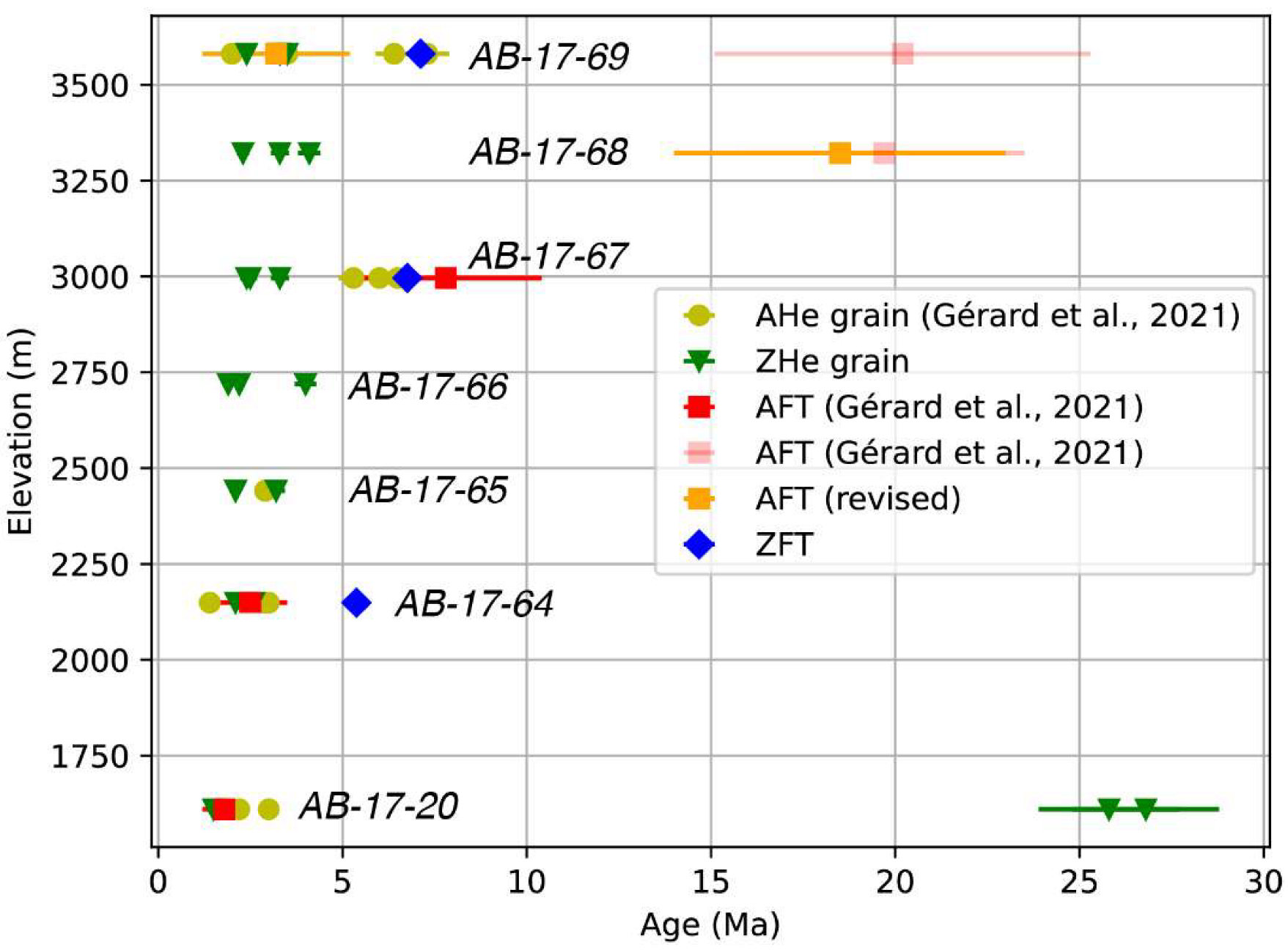



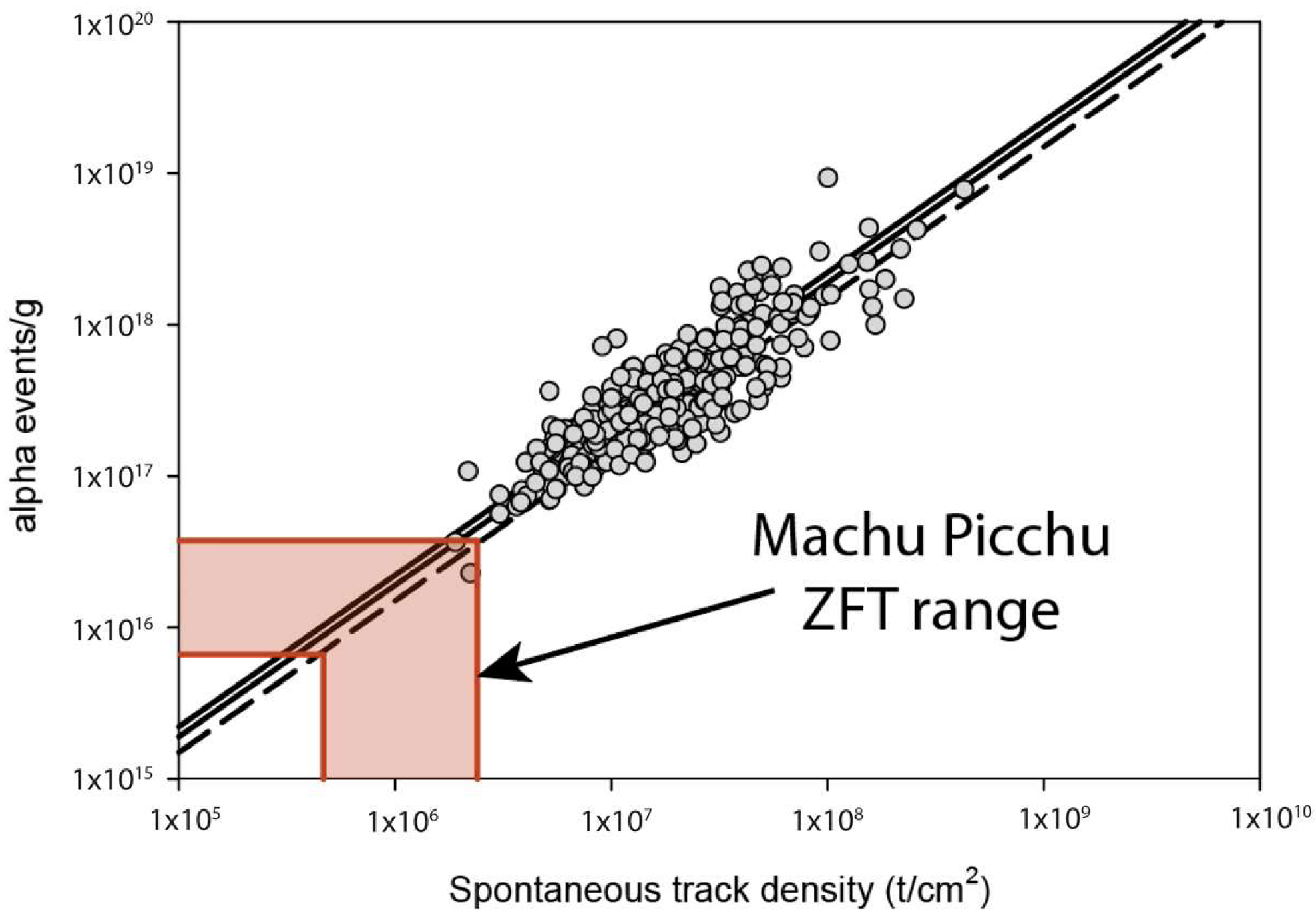
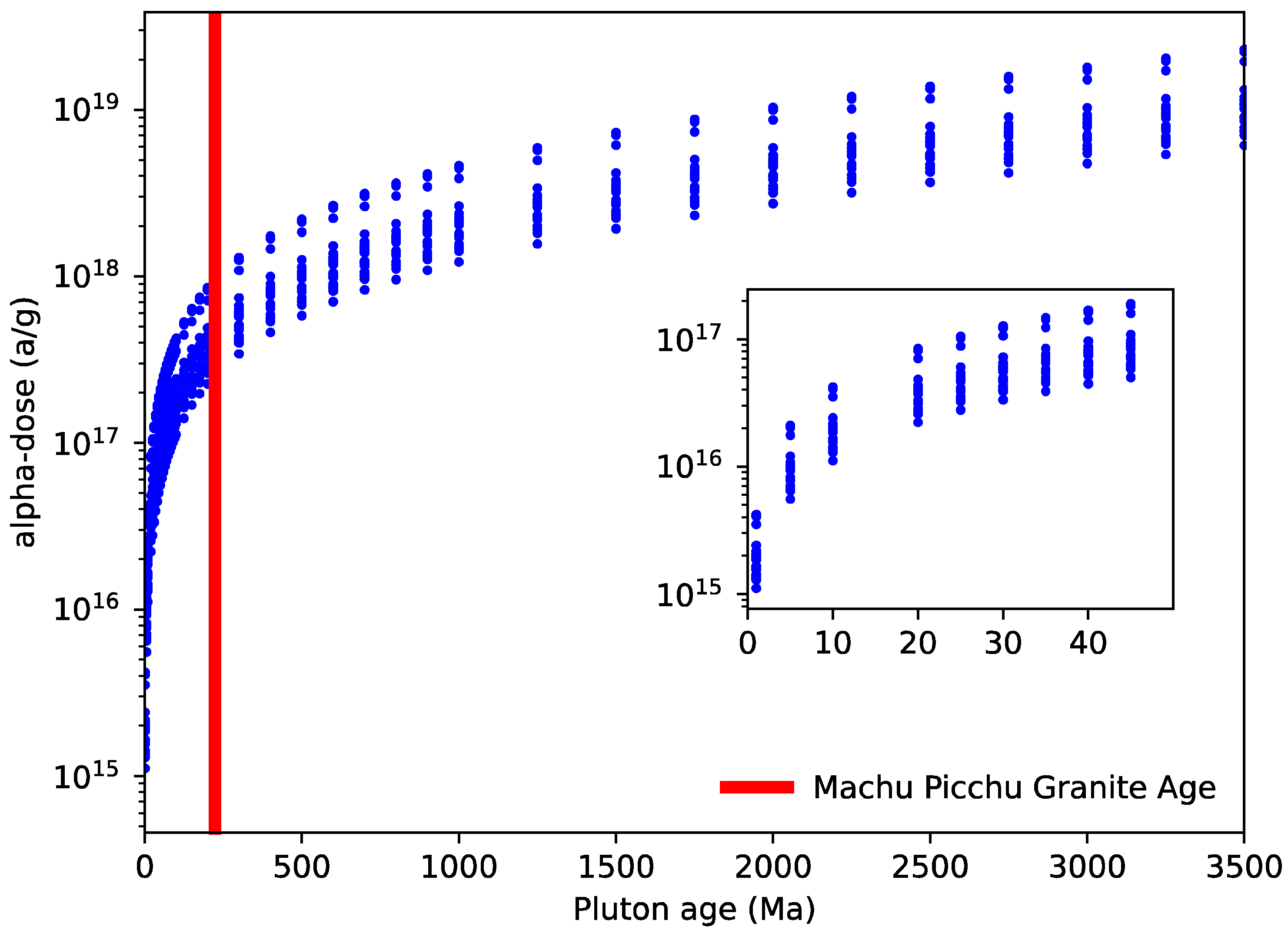
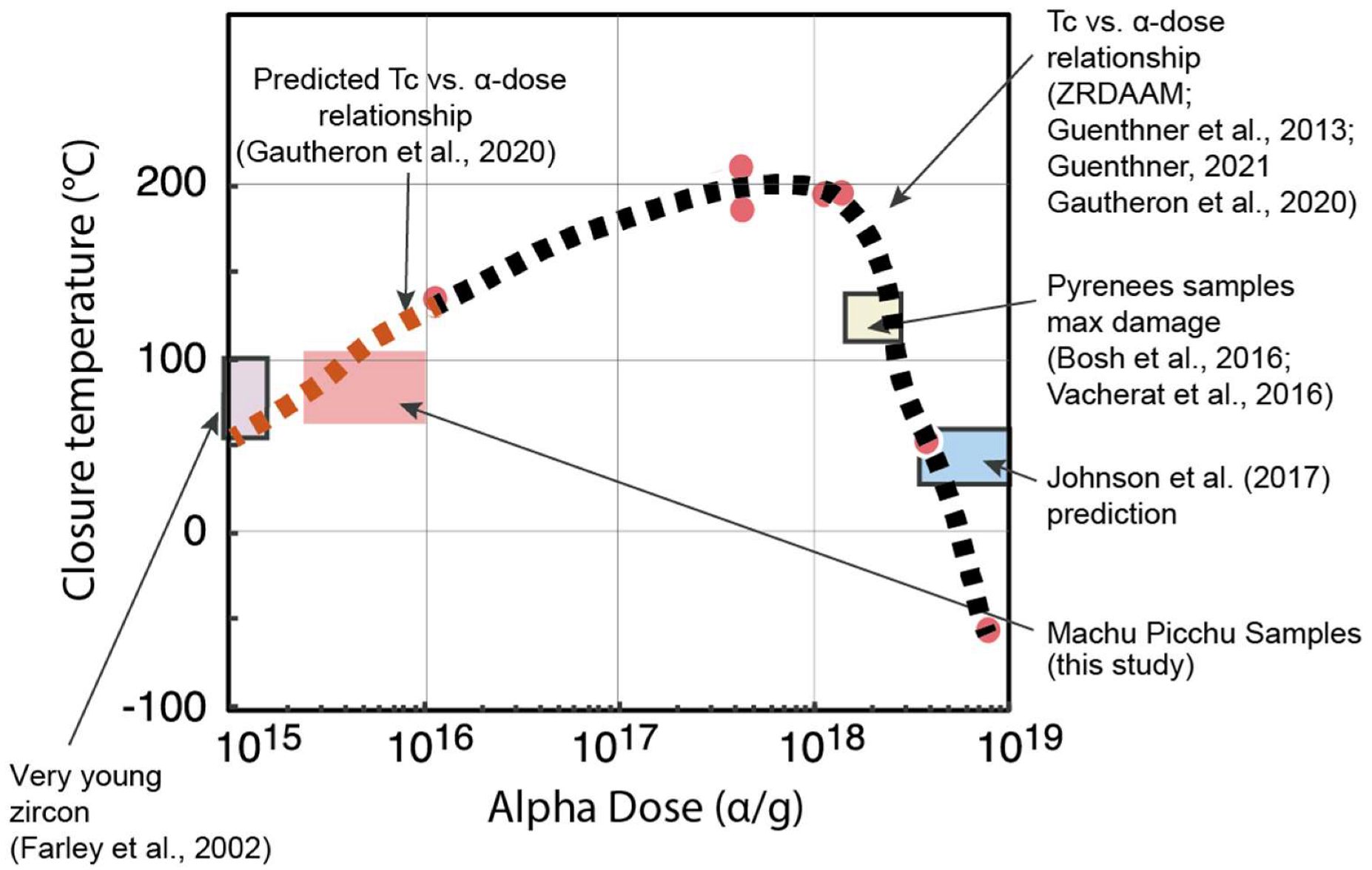
| Sample Number | Latitude (° S) | Longitude (° W) | Elevation (m) | Age (Ma) | U 2 (μg/g) | U 2 (ng) | Th 2 (μg/g) | Th 2 (ng) | 147Sm 2 (μg/g) | eU (μg/g) | Th/U | He 2 (nmol/g) | Err. He (nmol/g) | Mass (µg) | Ft | (μm) | Raw Age (Ma) | Err. (Ma) | |
|---|---|---|---|---|---|---|---|---|---|---|---|---|---|---|---|---|---|---|---|
| zFCT-61 1 | 30.7 | 2.3 | 373.0 | 2.3 | 191.9 | 1.2 | 0.0 | 417.1 | 0.5 | 53.0 | 4.2 | 6.1 | 0.8 | 49.8 | 23.5 | 1.7 | |||
| zFCT-62 1 | 29.8 | 2.2 | 315.3 | 1.9 | 168.2 | 1.0 | 0.0 | 354.0 | 0.5 | 44.0 | 3.5 | 6.2 | 0.8 | 51.5 | 23.0 | 1.7 | |||
| zAB1720-1 | 13.14182 | 72.58376 | 1610 | 25.8 | 1.9 | 470.4 | 4.5 | 400.7 | 3.8 | 0.0 | 562.6 | 0.9 | 62.2 | 5.0 | 9.6 | 0.8 | 57.2 | 20.4 | 1.5 |
| zAB1720-2 | 1.5 | 0.1 | 403.1 | 4.8 | 32.3 | 0.4 | 0.0 | 410.5 | 0.1 | 2.8 | 0.2 | 11.9 | 0.8 | 62.5 | 1.3 | 0.1 | |||
| zAB1720-3 | 26.8 | 2.0 | 452.7 | 5.0 | 332.8 | 3.6 | 0.0 | 529.3 | 0.7 | 61.7 | 4.9 | 11.0 | 0.8 | 61.4 | 21.5 | 1.6 | |||
| zAB1764-1 | 13.18747 | 72.52931 | 2149 | 2.1 | 0.2 | 516.0 | 6.9 | 248.1 | 3.3 | 0.0 | 573.1 | 0.5 | 5.4 | 0.4 | 13.3 | 0.8 | 65.5 | 1.7 | 0.1 |
| zAB1764-2 | 2.6 | 0.2 | 675.2 | 8.5 | 272.7 | 3.4 | 0.0 | 738.0 | 0.4 | 8.4 | 0.7 | 12.6 | 0.8 | 64.3 | 2.1 | 0.2 | |||
| zAB1764-3 | 2.4 | 0.2 | 440.2 | 6.1 | 152.5 | 2.1 | 0.1 | 475.4 | 0.3 | 5.1 | 0.4 | 13.8 | 0.8 | 66.7 | 2.0 | 0.1 | |||
| zAB1765-1 | 13.18833 | 72.53428 | 2441 | 3.2 | 0.2 | 541.9 | 4.3 | 298.8 | 2.4 | 0.1 | 610.7 | 0.6 | 8.3 | 0.7 | 7.9 | 0.8 | 55.5 | 2.5 | 0.2 |
| zAB1765-2 | 2.1 | 0.2 | 597.0 | 4.7 | 149.2 | 1.2 | 0.0 | 631.3 | 0.2 | 5.5 | 0.4 | 7.9 | 0.8 | 55.7 | 1.6 | 0.1 | |||
| zAB1765-3 | 2.1 | 0.2 | 459.1 | 5.2 | 147.9 | 1.7 | 0.0 | 493.2 | 0.3 | 4.6 | 0.4 | 11.4 | 0.8 | 64.3 | 1.7 | 0.1 | |||
| zAB1766-1 | 13.19034 | 72.5369 | 2719 | 4.0 | 0.3 | 503.9 | 3.3 | 312.4 | 2.0 | 0.0 | 575.9 | 0.6 | 9.6 | 0.8 | 6.5 | 0.8 | 51.3 | 3.1 | 0.2 |
| zAB1766-2 | 2.2 | 0.2 | 364.3 | 2.9 | 237.4 | 1.9 | 0.1 | 419.0 | 0.7 | 4.0 | 0.3 | 8.1 | 0.8 | 57.1 | 1.8 | 0.1 | |||
| zAB1766-3 | 1.9 | 0.1 | 403.0 | 3.1 | 141.0 | 1.1 | 0.0 | 435.5 | 0.3 | 3.6 | 0.3 | 7.6 | 0.8 | 54.0 | 1.5 | 0.1 | |||
| zAB1767-1 | 13.19288 | 72.54157 | 2996 | 2.5 | 0.2 | 464.8 | 4.0 | 182.4 | 1.6 | 0.0 | 506.8 | 0.4 | 5.4 | 0.4 | 8.6 | 0.8 | 57.9 | 2.0 | 0.1 |
| zAB1767-2 | 3.3 | 0.2 | 313.7 | 2.4 | 115.9 | 0.9 | 0.0 | 340.4 | 0.4 | 4.7 | 0.4 | 7.8 | 0.8 | 55.8 | 2.6 | 0.2 | |||
| zAB1767-3 | 2.4 | 0.2 | 613.7 | 7.0 | 220.0 | 2.5 | 0.1 | 664.3 | 0.4 | 7.1 | 0.6 | 11.4 | 0.8 | 63.5 | 2.0 | 0.1 | |||
| zAB1768-1 | 13.2029 | 72.53497 | 3322 | 2.3 | 0.2 | 1017.0 | 8.7 | 270.9 | 2.3 | 0.0 | 1079.4 | 0.3 | 10.5 | 0.8 | 8.6 | 0.8 | 58.5 | 1.8 | 0.1 |
| zAB1768-2 | 4.1 | 0.3 | 353.6 | 1.5 | 182.2 | 0.8 | 0.0 | 395.5 | 0.5 | 6.6 | 0.5 | 4.4 | 0.7 | 46.5 | 3.1 | 0.2 | |||
| zAB1768-3 | 3.3 | 0.2 | 1130.6 | 8.2 | 486.0 | 3.5 | 0.1 | 1242.6 | 0.4 | 17.3 | 1.4 | 7.2 | 0.8 | 55.4 | 2.6 | 0.2 | |||
| zAB1769-1 | 13.20652 | 72.53204 | 3581 | 3.5 | 0.3 | 508.5 | 5.8 | 257.9 | 3.0 | 0.0 | 567.9 | 0.5 | 8.8 | 0.7 | 11.4 | 0.8 | 62.9 | 2.9 | 0.2 |
| zAB1769-2 | 3.3 | 0.2 | 538.3 | 7.3 | 247.1 | 3.4 | 0.1 | 595.2 | 0.5 | 8.6 | 0.7 | 13.6 | 0.8 | 66.0 | 2.7 | 0.2 | |||
| zAB1769-3 | 2.4 | 0.2 | 1176.3 | 9.3 | 489.7 | 3.9 | 0.0 | 1289.1 | 0.4 | 13.3 | 1.1 | 7.9 | 0.8 | 55.9 | 1.9 | 0.1 |
| Sample | n | ρs (106 cm−2) | Ns | ρi (106 cm−2) | Ni | ρd 105 cm−2) | P (χ2) | Dispersion (%) | Age (Ma) | U (μg/g) | ||
|---|---|---|---|---|---|---|---|---|---|---|---|---|
| AB-17-64 | 20 | 1.4 | 587 | 6.7 | 2851 | 3.9 | 10.1 | 11.9 | 5.4 | 0.3 | 858 | 41 |
| AB-17-67 | 20 | 1.1 | 467 | 4.1 | 1776 | 3.9 | 59.2 | 0.7 | 6.8 | 0.4 | 528 | 29 |
| AB-17-68 | 20 | 1.2 | 418 | 4.4 | 1510 | 3.9 | 78.6 | 0.3 | 7.1 | 0.4 | 559 | 32 |
| Sample | n | ρs (105 cm−2) | Ns | ρi (105 cm−2) | Ni | ρd (105 cm−2) | P (χ2) | Dispersion (%) | Central Age (Ma) | U (μg/g) | n Dpar 2 |
MDpar 2 | n TL 2 |
MTL 2 | ||
|---|---|---|---|---|---|---|---|---|---|---|---|---|---|---|---|---|
| AB-17-68 | 10 | 4.8 | 78 | 53.3 | 851 | 14.3 | 69.4 | 0.2 | 18.5 | 5.1 | 53 | 4 | 74 | 1.5 | N.D. 3 | N.D. 3 |
| AB-17-69 | 11 | 3.0 | 8 | 19.3 | 522 | 14.4 | 45.2 | 13.6 | 3.1 | 3.2 | 19 | 2 | 42 | 1.0 | 3 | 11.9 |
| Case 1: 5–7 Ma Cooling | Case 2: Permo-Triasic Pluton Emplacement (222 Ma) without Reheating | Case 3: 1 Ga Pluton Emplacement without Reheating | |||||||
|---|---|---|---|---|---|---|---|---|---|
| Sample Number | Time (106 yr) | α -dose (α/g) | Estimated Tc Range (°C) 1 | Time (106 yr) | α-Dose (α/g) | Estimated Tc Range (°C) 1 | Time (109 yr) | α-Dose (α/g) | Estimated Tc Range (°C) 1 |
| zAB1720-2 | 5 | 50–100 | 222 | 150–200 | 1 | 110–130 | |||
| zAB1764-1 | 5 | 70–110 | 222 | 150–200 | 1 | 100–120 | |||
| zAB1764-2 | 5 | 100–140 | 222 | 150–200 | 1 | 100–120 | |||
| zAB1764-3 | 5 | 70–110 | 222 | 150–200 | 1 | 100–130 | |||
| zAB1765-1 | 5 | 70–110 | 222 | 150–200 | 1 | 100–120 | |||
| zAB1765-2 | 5 | 100–140 | 222 | 150–200 | 1 | 100–120 | |||
| zAB1765-3 | 5 | 70–110 | 222 | 150–200 | 1 | 100–130 | |||
| zAB1766-1 | 5 | 70–110 | 222 | 150–200 | 1 | 100–120 | |||
| zAB1766-2 | 5 | 70–110 | 222 | 150–200 | 1 | 100–130 | |||
| zAB1766-3 | 5 | 70–110 | 222 | 150–200 | 1 | 100–130 | |||
| zAB1767-1 | 6 | 70–110 | 222 | 150–200 | 1 | 100–130 | |||
| zAB1767-2 | 6 | 70–110 | 222 | 150–200 | 1 | 120–190 | |||
| zAB1767-3 | 6 | 100–140 | 222 | 150–200 | 1 | 100–120 | |||
| zAB1768-1 | 7 | 100–140 | 222 | 150–200 | 1 | 30–60 | |||
| zAB1768-2 | 7 | 70–110 | 222 | 150–200 | 1 | 100–130 | |||
| zAB1768-3 | 7 | 100–140 | 222 | 150–200 | 1 | 30–60 | |||
| zAB1769-1 | 8 | 100–140 | 222 | 150–200 | 1 | 100–120 | |||
| zAB1769-2 | 8 | 100–140 | 222 | 150–200 | 1 | 100–120 | |||
| zAB1769-3 | 8 | 100–140 | 222 | 150–200 | 1 | 30–60 | |||
Publisher’s Note: MDPI stays neutral with regard to jurisdictional claims in published maps and institutional affiliations. |
© 2022 by the authors. Licensee MDPI, Basel, Switzerland. This article is an open access article distributed under the terms and conditions of the Creative Commons Attribution (CC BY) license (https://creativecommons.org/licenses/by/4.0/).
Share and Cite
Gérard, B.; Robert, X.; Grujic, D.; Gautheron, C.; Audin, L.; Bernet, M.; Balvay, M. Zircon (U-Th)/He Closure Temperature Lower Than Apatite Thermochronometric Systems: Reconciliation of a Paradox. Minerals 2022, 12, 145. https://doi.org/10.3390/min12020145
Gérard B, Robert X, Grujic D, Gautheron C, Audin L, Bernet M, Balvay M. Zircon (U-Th)/He Closure Temperature Lower Than Apatite Thermochronometric Systems: Reconciliation of a Paradox. Minerals. 2022; 12(2):145. https://doi.org/10.3390/min12020145
Chicago/Turabian StyleGérard, Benjamin, Xavier Robert, Djordje Grujic, Cécile Gautheron, Laurence Audin, Matthias Bernet, and Mélanie Balvay. 2022. "Zircon (U-Th)/He Closure Temperature Lower Than Apatite Thermochronometric Systems: Reconciliation of a Paradox" Minerals 12, no. 2: 145. https://doi.org/10.3390/min12020145
APA StyleGérard, B., Robert, X., Grujic, D., Gautheron, C., Audin, L., Bernet, M., & Balvay, M. (2022). Zircon (U-Th)/He Closure Temperature Lower Than Apatite Thermochronometric Systems: Reconciliation of a Paradox. Minerals, 12(2), 145. https://doi.org/10.3390/min12020145







